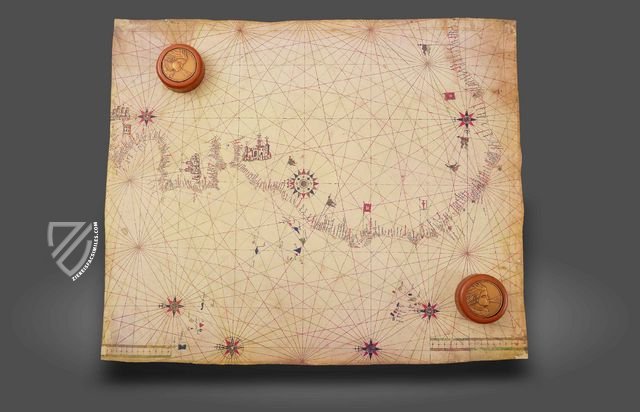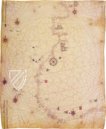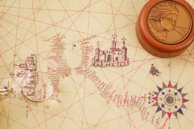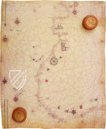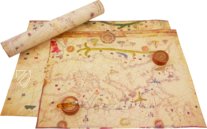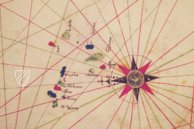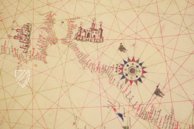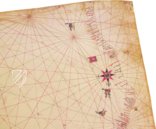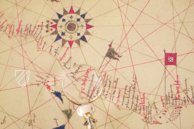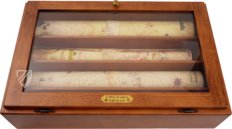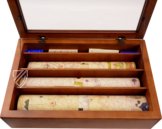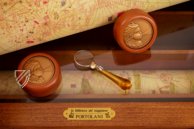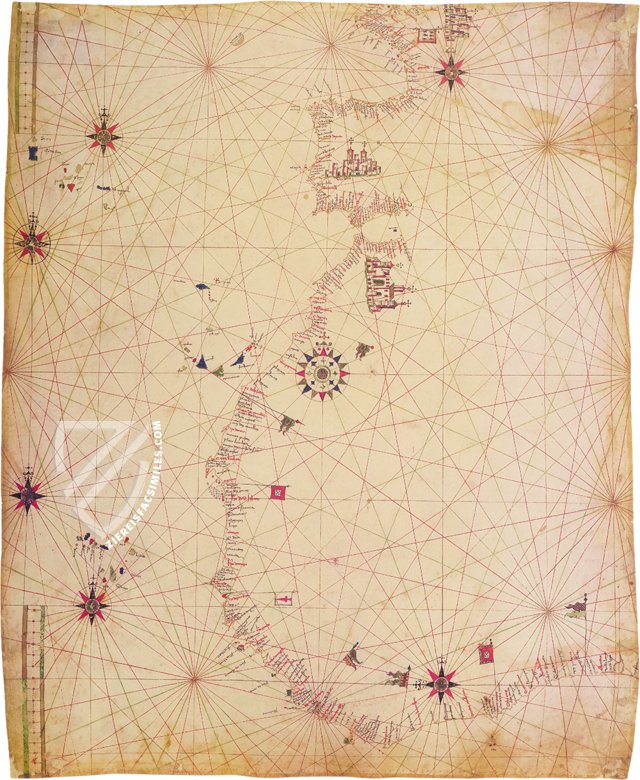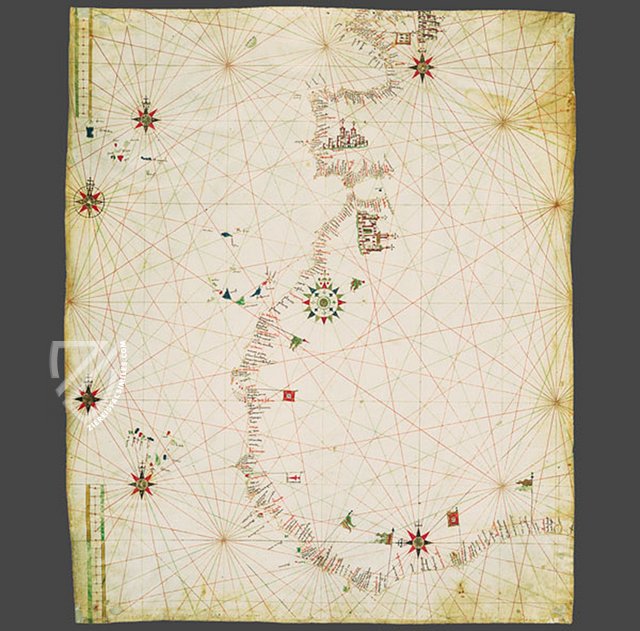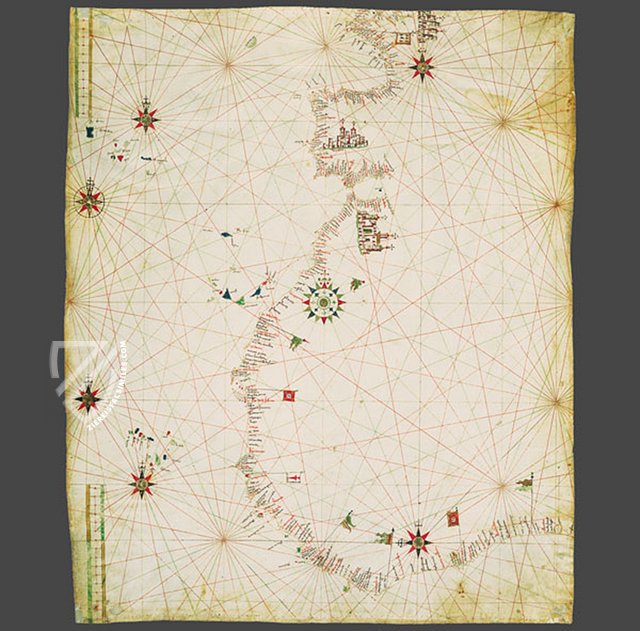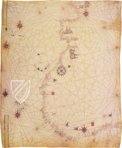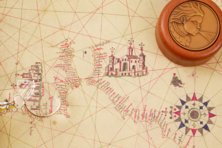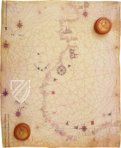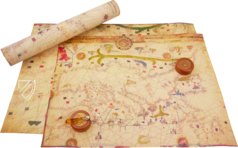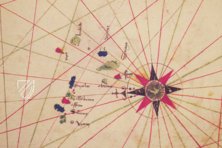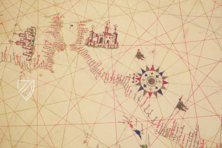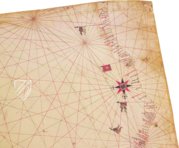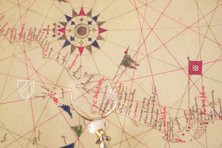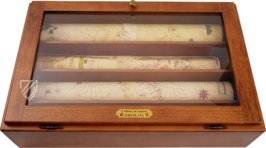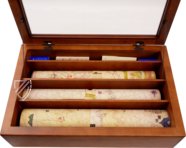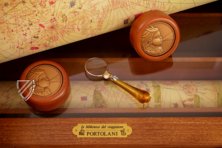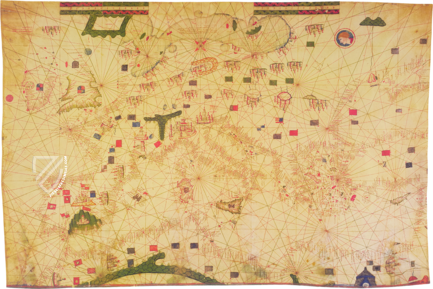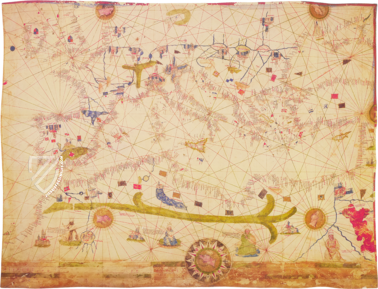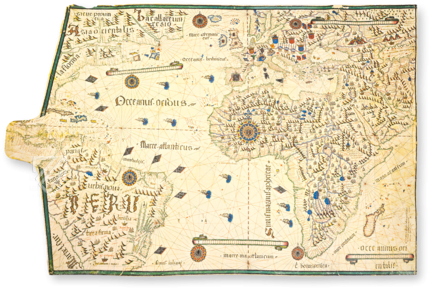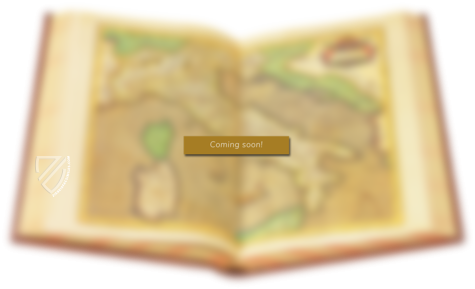Portulan C.G.A.5.c
(under 1,000€)
The Portulan C.G.A.5.c was created between 1472 and 1482 by a talented but anonymous Portuguese cartographer. It is the oldest evidence of Portuguese cartography, which produced arguably the most important school of cartography of the Renaissance and is known for its amazingly realistic nautical charts. Among other things, the map shows the discoveries on the coast of Africa, which Fernando Gomes made only shortly before it was created. In addition, the cities of Lisbon and Ceuta, which were flourishing at the time, were particularly highlighted. The level of detail of the correctly depicted coastlines is astonishing, making this map a particularly fascinating testimony to the early days of the Portuguese cartographic school, which is now kept in the Biblioteca Estense in Modena.
Portulan C.G.A.5.c
Portugal has played a special role in the history of cartography. Portuguese explorers set out into all of the lands and seas of the world and opened up completely unknown regions. In the course of this pioneering work, arguably the most important cartography schools of the European Renaissance developed in Portugal. Some of the most important historical works of the 15th century, which served as a cornerstone for our modern geography and navigation, had their origin here. Portulan C.G.A.5.c is the earliest example of a Portuguese nautical map. It displays discoveries on the coast of Africa by Fernando Gomes in the years 1471–2.
What is a Portulan?
The term portulan or portolan originally indicated a book with nautical information such as landmarks, lighthouses, currents, and harbor conditions. According to historical sources, such sea-books already existed in the 13th century. Beginning in the 16th century, the term broadened and from then on comprised not only the written descriptions, but also the accompanying nautical maps, which were contained in books. Today, the term “portulan chart” indicate a very precise type of map. The map Portulan C.G.A.5.c is one of these special maps.
The Geography of the Middle Ages
It is not known who exactly is responsible for the creation of Portulan C.G.A.5.c, but its formation period has been dated between 1472 and 1483. This is based on the special emphasis on the cities of Lisbon and Ceuta, which enjoyed a blossoming of trade and culture during this time. The faithfully detailed and geographically correct map demonstrates how astounding the knowledge of Portuguese cartographers was during the Renaissance. He managed to create maps completely without modern technical aids that are still of importance for our modern navigation today.
Codicology
- Alternative Titles
- Portolano GCA5c
Portolan map C.G.A.5.c
Portolan-Karte C.G.A.5.c
Modena Chart - Type
- Map on parchment
- Size / Format
- 1 map / 60.0 × 73.0 cm
- Origin
- Portugal
- Date
- 1472–1482
- Epochs
- Style
- Genre
- Language
- Script
- Humanistic
- Illustrations
- The map is decorated with detailed cityscapes and several wind roses as well as different colored flags
- Content
- Portolan chart of Europe, the Mediterranean, and new discoveries made along the West coast of Africa
Portulan C.G.A.5.c
Lisbon
In the 15th century, Lisbon, as the capital of the Kingdom of Portugal, developed into a leading centre of world trade. This Portulan map also takes this into account, which exceptionally highlights the city, here designated as vlixbona in red display script, by means of a schematic representation. Particularly remarkable is the exact course of the coastline, which also takes river mouths into account. Lisbon literally merges with the estuary of the Tagus River, to which it is geographically correct to approach from the north. Further down, the Strait of Gibraltar can be seen, while the Atlantic Ocean stretches out to the left.
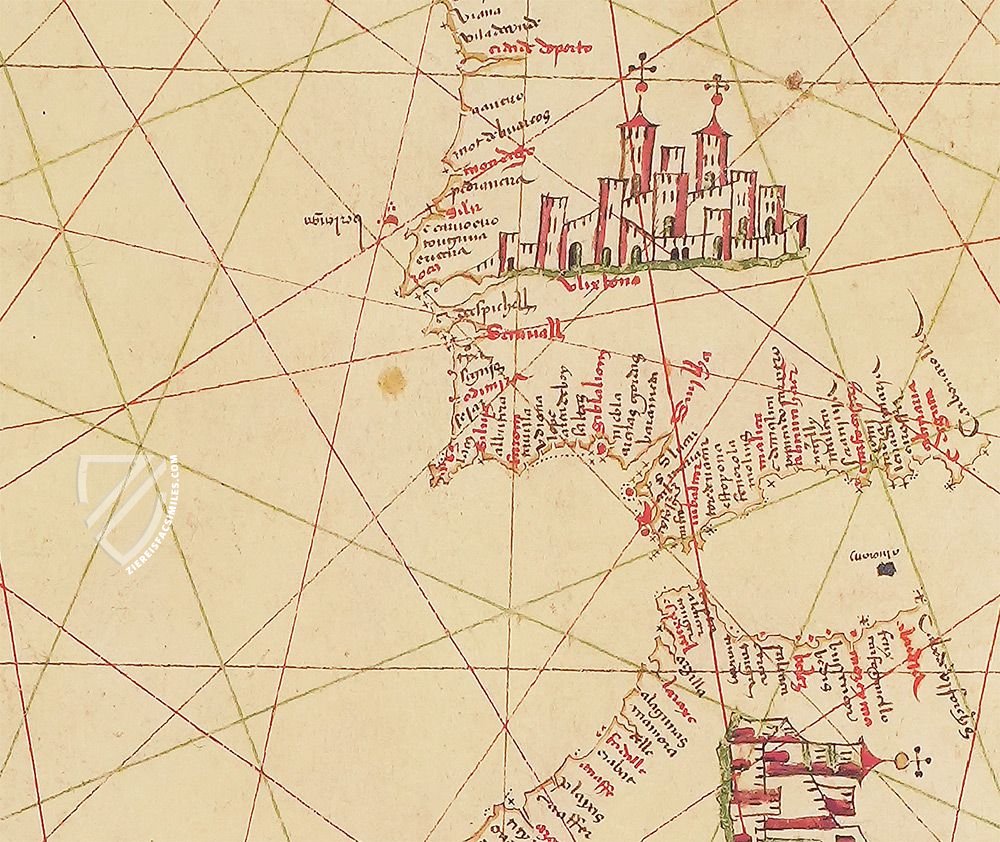
Portulan C.G.A.5.c
Nautical Chart of the Atlantic coasts of Africa, Spain, and France
This map is the oldest surviving document of medieval Portuguese cartography and documents their exploration of the West African coast after the discoveries made by Fernando Gomez during the years 1471–72. Various landing points are marked by flags with the royal Portuguese coat of arms and other heraldic devices. The islands and archipelagos off the coast including Cape Verde, the Canary Islands, and the Azores are colored red, blue, and green.
Three cities are illustrated on the map: Paris in the north while to the south we see Lisbon and the North African port city of Ceuta, which was conquered by King John I of Portugal in 1415 at the loss of only eight men before passing into Spanish control after the Iberian Union and continues to be an autonomous Spanish city today. Based upon all of the information found in the 60 x 73 cm map, researchers have dated it to between 1472 and 1482.
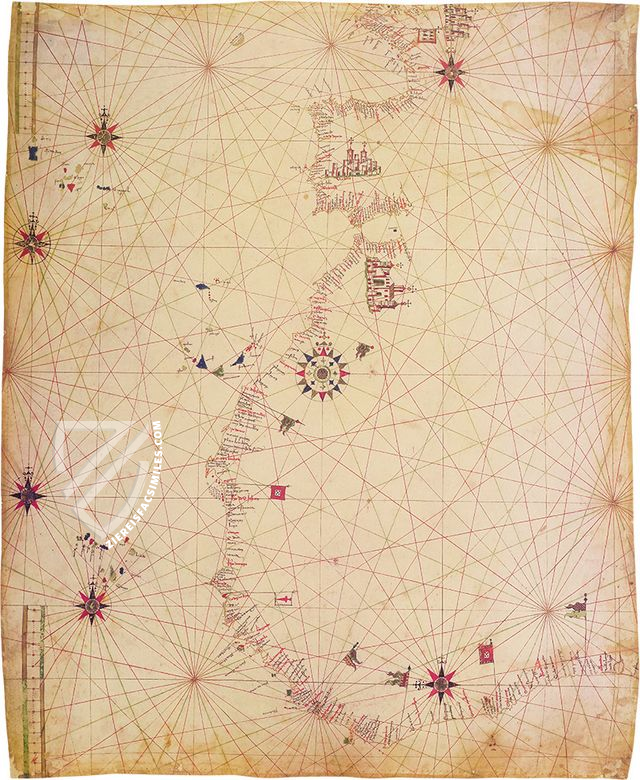
#1 Portolano C.G.A.5.c (map in tube)
Language: Italian
(under 1,000€)
#2 Portolani (set of 3 maps in case, includes C.G.A.5.c)
Language: Italian
(over 10,000€)
#3 Portolani (set of 3 maps in deluxe wooden case, includes C.G.A.5.c)
Language: Italian
(over 10,000€)
- Treatises / Secular Books
- Apocalypses / Beatus
- Astronomy / Astrology
- Bestiaries
- Bibles / Gospels
- Chronicles / History / Law
- Geography / Maps
- Saints' Lives
- Islam / Oriental
- Judaism / Hebrew
- Single Leaf Collections
- Leonardo da Vinci
- Literature / Poetry
- Liturgical Manuscripts
- Medicine / Botany / Alchemy
- Music
- Mythology / Prophecies
- Psalters
- Other Religious Books
- Games / Hunting
- Private Devotion Books
- Other Genres
- Afghanistan
- Armenia
- Austria
- Belgium
- Belize
- Bosnia and Herzegovina
- China
- Colombia
- Costa Rica
- Croatia
- Cyprus
- Czech Republic
- Denmark
- Egypt
- El Salvador
- Ethiopia
- France
- Germany
- Greece
- Guatemala
- Honduras
- Hungary
- India
- Iran
- Iraq
- Israel
- Italy
- Japan
- Jordan
- Kazakhstan
- Kyrgyzstan
- Lebanon
- Liechtenstein
- Luxembourg
- Mexico
- Morocco
- Netherlands
- Palestine
- Panama
- Peru
- Poland
- Portugal
- Romania
- Russia
- Serbia
- Spain
- Sri Lanka
- Sweden
- Switzerland
- Syria
- Tajikistan
- Turkey
- Turkmenistan
- Ukraine
- United Kingdom
- United States
- Uzbekistan
- Vatican City
- A. Oosthoek, van Holkema & Warendorf
- Aboca Museum
- Ajuntament de Valencia
- Akademie Verlag
- Akademische Druck- u. Verlagsanstalt (ADEVA)
- Aldo Ausilio Editore - Bottega d’Erasmo
- Alecto Historical Editions
- Alkuin Verlag
- Almqvist & Wiksell
- Amilcare Pizzi
- Andreas & Andreas Verlagsbuchhandlung
- Archa 90
- Archiv Verlag
- Archivi Edizioni
- Arnold Verlag
- ARS
- Ars Magna
- ArtCodex
- AyN Ediciones
- Azimuth Editions
- Badenia Verlag
- Bärenreiter-Verlag
- Belser Verlag
- Belser Verlag / WK Wertkontor
- Benziger Verlag
- Bernardinum Wydawnictwo
- BiblioGemma
- Biblioteca Apostolica Vaticana (Vaticanstadt, Vaticanstadt)
- Bibliotheca Palatina Faksimile Verlag
- Bibliotheca Rara
- Boydell & Brewer
- Bramante Edizioni
- Bredius Genootschap
- Brepols Publishers
- British Library
- C. Weckesser
- Caixa Catalunya
- Canesi
- CAPSA, Ars Scriptoria
- Caratzas Brothers, Publishers
- Carus Verlag
- Casamassima Libri
- Centrum Cartographie Verlag GmbH
- Chavane Verlag
- Christian Brandstätter Verlag
- Circulo Cientifico
- Club Bibliófilo Versol
- Club du Livre
- CM Editores
- Collegium Graphicum
- Collezione Apocrifa Da Vinci
- Comissão Nacional para as Comemorações dos Descobrimentos Portugueses
- Coron Verlag
- Corvina
- CTHS
- D. S. Brewer
- Damon
- De Agostini/UTET
- De Nederlandsche Boekhandel
- De Schutter
- Deuschle & Stemmle
- Deutscher Verlag für Kunstwissenschaft
- DIAMM
- Droz
- E. Schreiber Graphische Kunstanstalten
- Ediciones Boreal
- Ediciones Grial
- Ediclube
- Edições Inapa
- Edilan
- Editalia
- Edition Deuschle
- Edition Georg Popp
- Edition Leipzig
- Edition Libri Illustri
- Editiones Reales Sitios S. L.
- Éditions de l'Oiseau Lyre
- Editions Medicina Rara
- Editorial Casariego
- Editorial Mintzoa
- Editrice Antenore
- Editrice Velar
- Edizioni Edison
- Egeria, S.L.
- Eikon Editores
- Electa
- Emery Walker Limited
- Enciclopèdia Catalana
- Eos-Verlag
- Ephesus Publishing
- Ernst Battenberg
- Eugrammia Press
- Extraordinary Editions
- Fackelverlag
- Facsimila Art & Edition
- Facsimile Editions Ltd.
- Facsimilia Art & Edition Ebert KG
- Faksimile Verlag
- Feuermann Verlag
- Folger Shakespeare Library
- Franco Cosimo Panini Editore
- Friedrich Wittig Verlag
- Fundación Hullera Vasco-Leonesa
- G. Braziller
- Gabriele Mazzotta Editore
- Gebr. Mann Verlag
- Gesellschaft für graphische Industrie
- Getty Research Institute
- Giovanni Domenico de Rossi
- Giunti Editore
- Graffiti
- Grafica European Center of Fine Arts
- Guido Pressler
- Guillermo Blazquez
- Gustav Kiepenheuer
- H. N. Abrams
- Harrassowitz
- Harvard University Press
- Helikon
- Hendrickson Publishers
- Henning Oppermann
- Herder Verlag
- Hes & De Graaf Publishers
- Hoepli
- Holbein-Verlag
- Houghton Library
- Hugo Schmidt Verlag
- Idion Verlag
- Il Bulino, edizioni d'arte
- ILte
- Imago
- Insel Verlag
- Insel-Verlag Anton Kippenberger
- Instituto de Estudios Altoaragoneses
- Instituto Nacional de Antropología e Historia
- Introligatornia Budnik Jerzy
- Istituto dell'Enciclopedia Italiana - Treccani
- Istituto Ellenico di Studi Bizantini e Postbizantini
- Istituto Geografico De Agostini
- Istituto Poligrafico e Zecca dello Stato
- Italarte Art Establishments
- Jan Thorbecke Verlag
- Johnson Reprint Corporation
- Josef Stocker
- Josef Stocker-Schmid
- Jugoslavija
- Karl W. Hiersemann
- Kasper Straube
- Kaydeda Ediciones
- Kindler Verlag / Coron Verlag
- Kodansha International Ltd.
- Konrad Kölbl Verlag
- Kurt Wolff Verlag
- La Liberia dello Stato
- La Linea Editrice
- La Meta Editore
- Lambert Schneider
- Landeskreditbank Baden-Württemberg
- Leo S. Olschki
- Les Incunables
- Liber Artis
- Library of Congress
- Libreria Musicale Italiana
- Lichtdruck
- Lito Immagine Editore
- Lumen Artis
- Lund Humphries
- M. Moleiro Editor
- Maison des Sciences de l'homme et de la société de Poitiers
- Manuscriptum
- Martinus Nijhoff
- Maruzen-Yushodo Co. Ltd.
- MASA
- Massada Publishers
- McGraw-Hill
- Metropolitan Museum of Art
- Militos
- Millennium Liber
- Müller & Schindler
- Nahar - Stavit
- Nahar and Steimatzky
- National Library of Wales
- Neri Pozza
- Nova Charta
- Oceanum Verlag
- Odeon
- Orbis Mediaevalis
- Orbis Pictus
- Österreichische Staatsdruckerei
- Oxford University Press
- Pageant Books
- Parzellers Buchverlag
- Patrimonio Ediciones
- Pattloch Verlag
- PIAF
- Pieper Verlag
- Plon-Nourrit et cie
- Poligrafiche Bolis
- Presses Universitaires de Strasbourg
- Prestel Verlag
- Princeton University Press
- Prisma Verlag
- Priuli & Verlucca, editori
- Pro Sport Verlag
- Propyläen Verlag
- Pytheas Books
- Quaternio Verlag Luzern
- Reales Sitios
- Recht-Verlag
- Reichert Verlag
- Reichsdruckerei
- Reprint Verlag
- Riehn & Reusch
- Roberto Vattori Editore
- Rosenkilde and Bagger
- Roxburghe Club
- Salerno Editrice
- Saltellus Press
- Sandoz
- Sarajevo Svjetlost
- Schöck ArtPrint Kft.
- Schulsinger Brothers
- Scolar Press
- Scrinium
- Scripta Maneant
- Scriptorium
- Shazar
- Siloé, arte y bibliofilia
- SISMEL - Edizioni del Galluzzo
- Sociedad Mexicana de Antropología
- Société des Bibliophiles & Iconophiles de Belgique
- Soncin Publishing
- Sorli Ediciones
- Stainer and Bell
- Studer
- Styria Verlag
- Sumptibus Pragopress
- Szegedi Tudomànyegyetem
- Taberna Libraria
- Tarshish Books
- Taschen
- Tempus Libri
- Testimonio Compañía Editorial
- Thames and Hudson
- The Clear Vue Publishing Partnership Limited
- The Facsimile Codex
- The Folio Society
- The Marquess of Normanby
- The Richard III and Yorkist History Trust
- Tip.Le.Co
- TouchArt
- TREC Publishing House
- TRI Publishing Co.
- Trident Editore
- Tuliba Collection
- Typis Regiae Officinae Polygraphicae
- Union Verlag Berlin
- Universidad de Granada
- University of California Press
- University of Chicago Press
- Urs Graf
- Vallecchi
- Van Wijnen
- VCH, Acta Humaniora
- VDI Verlag
- VEB Deutscher Verlag für Musik
- Verlag Anton Pustet / Andreas Verlag
- Verlag Bibliophile Drucke Josef Stocker
- Verlag der Münchner Drucke
- Verlag für Regionalgeschichte
- Verlag Styria
- Vicent Garcia Editores
- W. Turnowski Ltd.
- W. Turnowsky
- Waanders Printers
- Wiener Mechitharisten-Congregation (Wien, Österreich)
- Wissenschaftliche Buchgesellschaft
- Wissenschaftliche Verlagsgesellschaft
- Wydawnictwo Dolnoslaskie
- Xuntanza Editorial
- Zakład Narodowy
- Zollikofer AG

